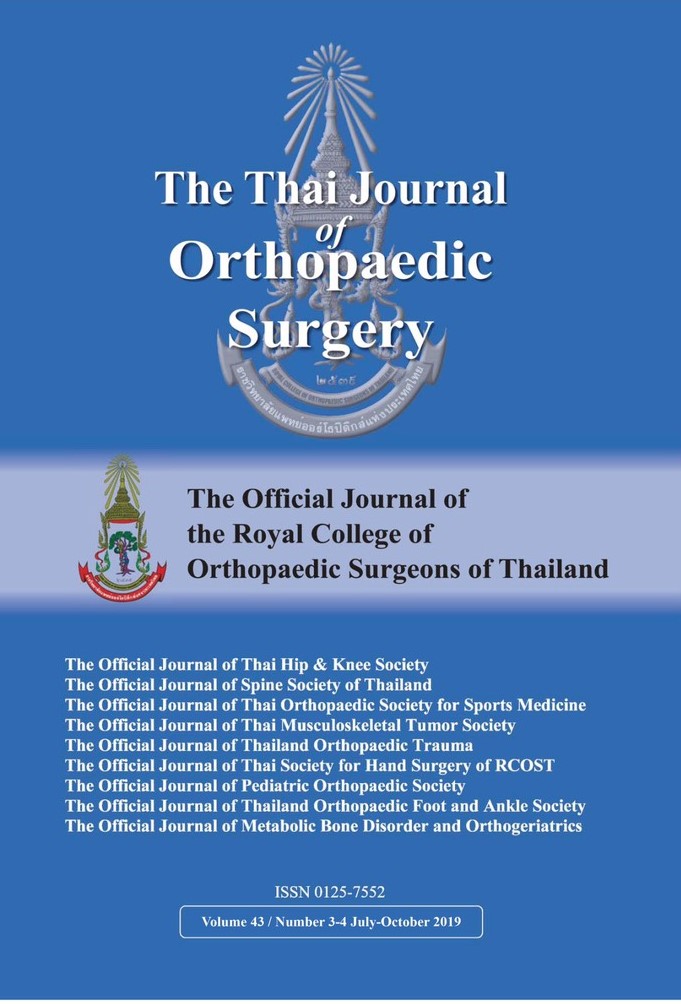Cost Analysis of Intra-Articular Treatment of Cross-Linked Sodium Hyaluronate (XLHA-BDDE) for Failure Conservative Treatment Patient with Multiples Stages Knee Osteoarthritis
Main Article Content
Abstract
Background: Hyaluronic acid injections are recognized as safe and effective for knee osteoarthritis (OA), with positive clinical evidence demonstrated in clinical trials. The clinical efficacy demonstrated that a single injection cross-linked sodium hyaluronate (XLHA, single injection form, Hyruan One) was non-inferior to three weekly injections of high molecular weight hyarulonic acid (HMWHA), and supports as effective and safe treatment for knee OA. The research is needed to find out more about the aspects of XLHA may influence medical and surgical cost in the clinical practices.
Objectives: The primary endpoint is cost analysis about disease-specific costs of medical and surgical treatments for 6 months before and after XLHA injection. The secondary endpoints are proportion of patient who were delayed for surgical interventions.
Methods: Cost analysis study was performed by enrolling patient with knee OA that failed conservative treatment, whom were candidate for surgical intervention, including 205 patients (253 knees) 40 males and 165 females during January 2018 till September 2018 and at Orthopedic Clinic, Police General Hospital. Patients were divided into two groups, first group age less than 60 years (48 patients) and second group age more than 60 years (157 patients) due to its different kind of operation. The disease severity was classified according to Kellgren Lawrence classification. Integrated medical and pharmacy claims data were extracted from HIS systems and also financial department of the Police General Hospital.
Results: The average age was 63.2 (50-81) years old. Patients were divided into 2 group by age, first under 60 and second above 60 years old, 48 and 157 patients respectively. In first group, there were 7 patient that need arthroscopic surgery, other 41 patients do not required surgery. Therefore, the percentage of patient that were delayed for surgical intervention is 85.42% (41/48) patients and the average cost for arthroscopic surgery were 69,750 baht per knee. In second group, 15 patients (17 knees) from 141 patients need total knee arthroplasty (TKA). We calculate into total proportion of 90.44% (142/157) patients that were delayed for TKA at 6 months and the average cost for TKA were 136,910.71 baht per knee. The cost of injection were 3,588,805 baht. The total medical costs (cox-2& diacerein) were 481,783 baht before 6 months injection and after 6 months injection were 701,714 baht.
Conclusion: In our study XLHA may improve outcomes, not only mild to moderate but also severe OA with 6 months follow up. The most common causes of failure under age of 60 years were the complex tear of meniscus and above 60 years were severe cartilage damage. The medical cost of selective cox-2 and diacerein increases but due high amount of patient that were delayed for surgical intervention, the surgical cost decreases significantly.
Article Details
References
2. Ha CW, Park YB, Choi CH, Kyung HS, Lee JH, Yoo JD, et al. Efficacy and safety of single injection ofcross-linked sodium hyaluronate vs. threeinjections of high molecular weight sodiumhyaluronate for OA of the knee: adouble-blind, randomized, multi-center,non-inferiority study. BMC Musculoskelet Disord. 2017; 18(1): 223.
3. Lisignoli G, Grassi F, Zini N, Toneguzzi S, Piacentini A, Guidolin D, et al. Anti-Fas-induced apoptosis in chondrocytes reduced by hyaluronan: evidence for CD44 and CD54 (intercellular adhesion molecule 1) involvement. Arthritis Rheum 2001; 44(8): 1800-7.
4. Maheu E, Rannou F, Reginster JY. Efficacy and safety of hyaluronic acid in the management of OA: Evidence from real-life setting trials and surveys. Semin Arthritis Rheum. 2016; 45(4 Suppl): S28-33.
5. Kellgren JH, Lawrence JS. Radiological assessment of osteo-arthrosis. Ann Rheum Dis. 1957; 16(4): 494-502
6. Turajane T, Larbpiboonpong V, Maungsiri S. Therapeutic effects of intra-articular hyaluronan on failed conservative treatment of knee OA. The Thai Journal of Orthopedic Surgery. 2004; 29(2): 85-9.
7. Turajane T, Amphansap T, Labpiboonpong V, Maungsiri S. Total knee replacement following repeated cycles of intra-articular sodium hyaluronate (500-730 Kda) in failed conservative treatment of knee osteoarthritis: a 54-month follow-up. J Med Assoc Thai. 2009; 92 Suppl 6: S63-8.
8. Zhang W, Moskowitz RW, Nuki G, Abramson S, Altman RD, Arden N, et al. OARSI recommendations for the management of hip and knee osteoarthritis, Part II: OARSI evidence-based, expert consensus guidelines. Osteoarthritis Cartilage. 2008; 16(2): 137-62.
9. Dasa V, DeKoven M, Sun K, Scott A, Lim S. Clinical and cost outcomes from different hyaluronic acid treatments in patients with knee osteoarthritis: evidence from a US health plan claims database. Drugs Context. 2016; 5: 212296.
10. Raman R, Henrotin Y, Chevalier X, Migliore A, Jerosch J, Montfort J, et al. Decision algorithms for the retreatment with viscosupplementation in patients suffering from Knee Osteoarthritis: Recommendations from the EUROpean VIScosupplementation COnsensus Group (EUROVISCO). Cartilage. 2018; 9(3): 263-75.
11. Altman RD, Akermark C, Beaulieu AD, Schnitzer T; Durolane International Study Group. Efficacy and safety of a single intra-articular injection of non-animalstabilized hyaluronic acid (NASHA) in patients with OA of the knee. Osteoarthritis Cartilage. 2004; 12(8): 642-9.
12. A˚ kermark C, Berg P, Bjo¨rkman A, Malm P. Non-animal stabilised hyaluronic acid in the treatment of OA of the kneeda tolerability study. Clin Drug Invest 2002; 22: 157-66.
13. Adams ME. An analysis of clinical studies of the use of cross-linked hyaluronan, hylan, in the treatmentof OA. J Rheumatol. 1993; 20(Suppl 39): 16-8.
14. Vannabouathong C, Bhandari M, Behi M. Non-operative treatments for knee OA: Are they equally effective? Poster presentation number p0763, AAOS annual meeting Lasvagus, 2019.


